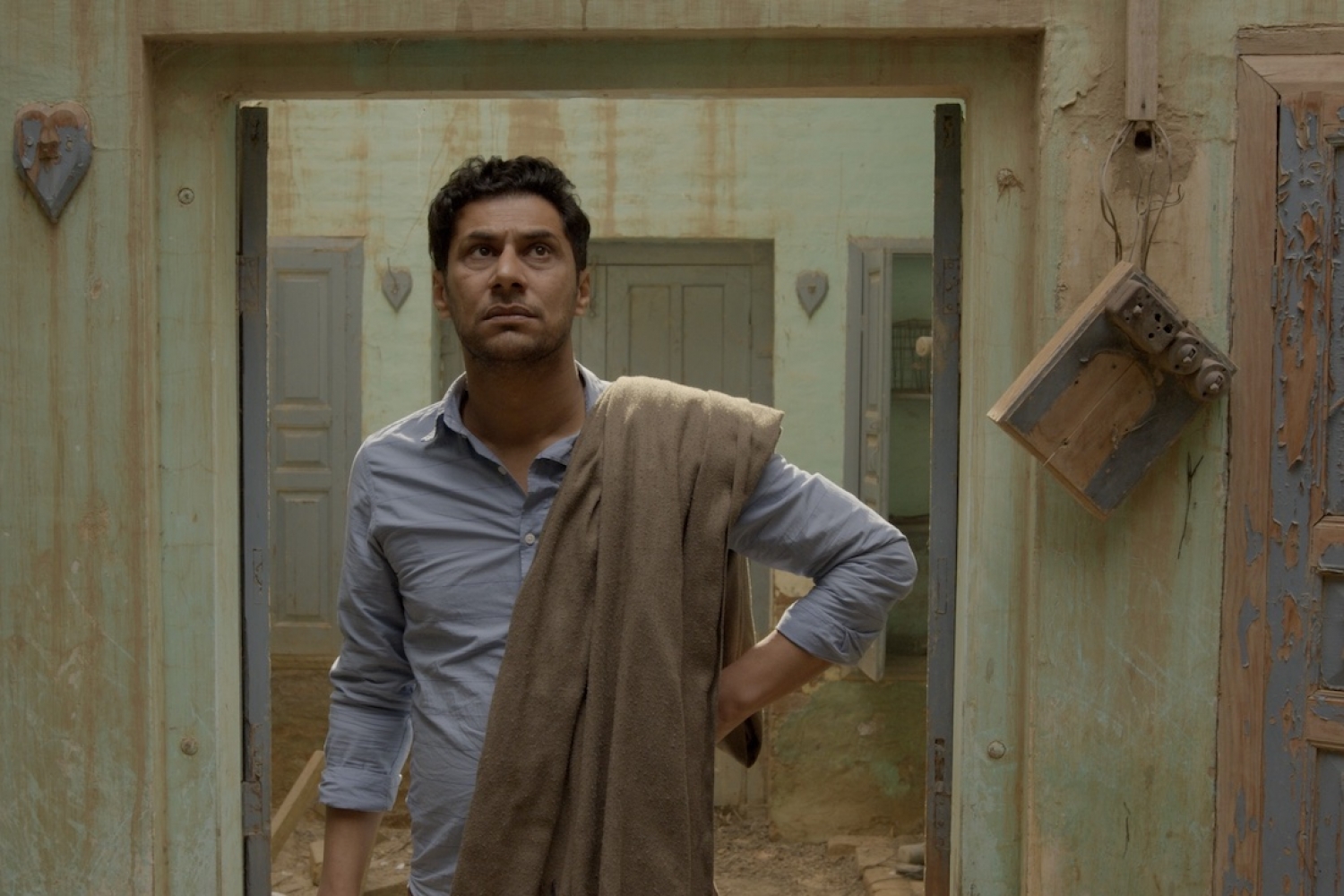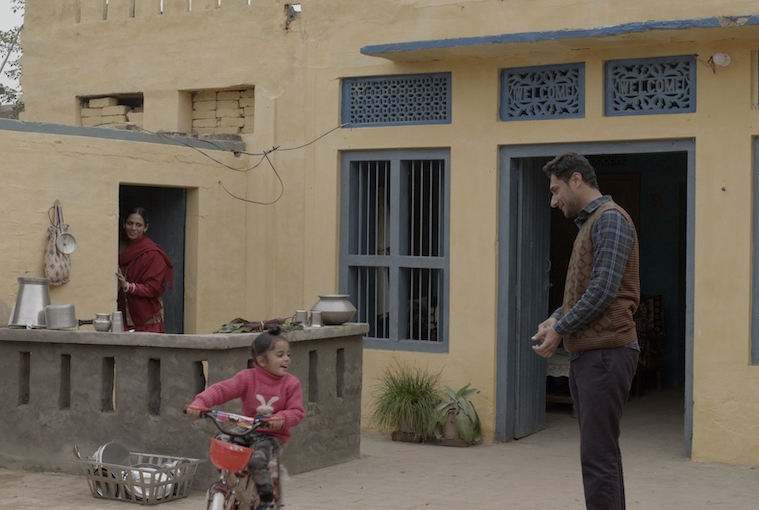
A film still from Adh Chanani Raat

A film still from Adh Chanani Raat
National Award-winning filmmaker Gurvinder Singh’s new film in Punjabi language, Adh Chanani Raat (Crescent Night), had its world premiere at the prestigious 52nd International Film Festival Rotterdam (IFFR) recently. The film was part of the Harbour section that offers a safe haven to the full range of contemporary cinema the festival champions. Adh Chanani Raat is Gurvinder Singh’s third feature in the trilogy of Punjabi language films after Anhey Ghorey Da Daan (2011 Venice Film Festival, Orizzonti) and Chauthi Koot (2015 Cannes Film Festival, Un Certain Regard) to be adapted from literary works of noted Punjabi authors. Also, this is Gurvinder’s second feature inspired from Gurdial Singh’s novel by the same name after his highly acclaimed debut feature, Anhey Ghorey Da Daan (Alms for a Blind Horse).
Set in rural Punjab, Adh Chanani Raat features an ensemble cast including acting debuts of Jatinder Mauhar as Modan (noted Punjabi filmmaker of Qissa Panjab, Mitti, Sarsa), Mauli Singh as Sukhi (indie publicist/producer) and professional actors like Samuel John (Ruldu), Raj Singh Jhinger (Geja), Dharminder Kaur (mother). It is shot by Satya Rai Nagpaul and edited by Avneesh Chhabra, with music by Marc Marder, costumes by Navjeet Kaur and dialogues by Jasdeep Singh.
We are in conversation with the filmmaker, who tells us more about the film and his future.
Adh Chanani Raat is your second feature to be inspired from Gurdial Singh’s novel by the same name after your highly acclaimed debut feature, Anhey Ghorey Da Daan. How did you come to make it?
Thematically and structurally it resonated with the kind of work I wish to do formally and cinematically. There is this restless quality in all the characters of Gurdial Singh. There is angst and sense of having been wronged. Modan was the sort of character I could identify with, both soft and gentle and yet prone to bursts of anger. Wrath leads him to commit a premeditated murder of his family’s wrongdoer. He is someone who wishes to move on from all the violence that a feudal structure and pride in possession of land and property brings. Starting a new chapter in his life, he tries his best to not be provoked, but is it possible to change your nature to become someone else? From resisting provocation to himself becoming the provocateur!
What is it about Punjab and its culture that intrigues you?
I don’t think I can call it love, when all my films portray a more dejected sense of the land. There is a dreariness and sadness in the rural life which comes across in my films. It’s not your hip-hop, happy-go-lucky people you see in popular cinema, both Hindi and Punjabi. Language definitely. That’s the primary reason I am making films in Punjabi against all odds: making arthouse cinema in a language for which there is almost no audience for such cinema. My work would have been much more acknowledged had I belonged to another state like Kerala or Maharashtra. But the common man here in Punjab knows nothing about my work. Neither does the mainstream media, nor does the state. The latter has no policy for films. The popular Punjabi film industry is amateurish. Terrible craft, superficial acting and themes sloshed in Jatt pride and identity.
And nothing is happening in music either though there is an abundance of talent. The same old rehashed themes of betrayed love, ego and revenge. And it all sounds the same. So much superior work has happened across the border with new Punjabi music. You have singers bringing a sense of modernity to old forms like Sufi, Folk and Ghazal, like Ali Sethi. Same with Sufi-Pop as a genre. Coke Studio Pakistan has done some outstanding work in bringing forth old texts, juxtaposing them and rearranging them with modern technology, though some of it fails to move and is overtly ornamental in its instrumental arrangement. I will dare say that the Punjabi culture we are nostalgic about survives only across the border, though they have faced more severe challenges in the survival of Punjab language due to the animosity of the Islamic state towards languages other than Urdu. Culturally, the scenario is very bleak here. The visual arts are totally dead. The folk performing arts are on their last leg. And there is very little in terms of good literature as well. Will there ever be a cultural renaissance is impossible to tell. For now, migrating to the developed world is the only aspiration.
How challenging is it to adapt such noteworthy work of literature for the screen? Can you talk in context of Adh Chanani Raat.
The challenge is to bring a sense of contemporaneity and making it believable in the present. Socially things have changed and evolved, as have the circumstances and people since the novel was written. Agriculture and people’s landholdings and dwellings have changed. The large landholding class has prospered due to migration to the west and rising land prices due to urbanisation. They all move around in big cars and own bungalows in cities like Chandigarh and Ludhiana. The small landowners are converting their ancestral homes in villages into bungalows. The Dalits have more voice as we are witnessing in the current elections with the appointment of a Dalit as the Chief Minister of Punjab. So you have to take all these factors into account while adapting for the present.
The Modan, Ruldu and Sukhi of the novel are very different from the ones you see on the screen. It was important to bring them into the everyday today. That’s why Adh Chanani Raat is less of an adaptation and more of an inspiration for the film, as is stated in the opening credits. The film takes the premise and plot of the novel and builds upon it, and also deviates by giving a more hopeful scenario. The novel is much bleaker. But then the way I end the film, the bleakness returns. It deviates, yet is faithful in spirit to the literary work.
The ensemble cast of the film made a big difference to the film. Can you talk a little about the actors?
I have known Mauli since she came on board as a publicist for Chauthi Koot. Being a Punjabi with background in theatre, I had no doubt she will fit the role. She is active and has an energy which is looking for new experiences. As Sukhi, she starts a new life after a failed first marriage. I saw Mauli as someone capable of doing that in her personal life. An actor has to eventually direct themselves from their inner reserve and past experiences. As a director, I only nudge them a little and tell them what to avoid. Jatinder himself is a film director. So he knows the medium very closely. He has a distinct and attractive face. I didn’t want Modan to be typical, turban and kurta wearing, beard sporting Jatt. Modan as a clean shaven and trouser wearing man is the picture of today’s farmer. And more importantly, I could see him as gentle and fierce at the same time.
Samuel John is a Chandigarh based theatre activist who played the lead in Anhey Ghorhey Da Daan. There was a desire to work with him again. He has that energy and extrovert quality that I was looking for in the role of Ruldu. He is articulate on social matters and renders a long monologue in the film while driving a motorbike with his long time friend Modan sitting behind him. Only Samuel could have pulled it off. Perhaps this is the only film in which I have not cast any non-actors, even though it’s a debut for both Mauli and Jatinder. As far as I am aware, they both wish to continue acting.

The background score also kept up with the grim tone of the film.
This is the third film where I have collaborated with Marc Marder, a Paris-based composer. I have consciously avoided using Indian or Punjabi music influences in the background score. I feel cinema is not a culture specific art form, even though it narrates culture specific stories. The medium itself is a technological invention not intended for application in any particular culture. Cinematography and sound recording technologies evolve at a global level. Filmmakers have used technicians from other countries regularly. It’s a global art form today, more so with the ease of reach in the digital era. A film does not need to underscore its rootedness by employing local or ethnic music. What you see on screen and hear in terms of diegetic sounds and dialogues is rooted enough.
Music that is beyond cultural references is what I am looking for and Marc has understood this very well. Even though he has exposed himself to Indian music in terms of listening while composing for my films. When we first collaborated on Chauthi Koot, I asked him to listen to a lot of Dhrupad. Somewhere, subconsciously, that sense of depth that this oldest form of Indian classical music evokes, finds its way into his compositions. And remarkably, most of the compositions he does are without looking at the film’s edit. He works mostly with script as a reference. He composes freely without specifying a scene and I choose and place it as a sound designer. Some compositions don’t find a way into the film, but many do.
What are your thoughts on the independent cinema movement in India?
It’s really heartening to see new films and new voices coming up every year and making an impact at the global level in film festivals. I suppose it has never been this varied. Also, independent filmmaking has moved beyond dependence on government funding. Which is a good thing, but unfortunate in terms of the government’s role in promoting such cinema. Even though many films are being made, the struggle to make them is phenomenal in the face of no structured support, either public or private. A country as big as ours has no organised funds for this cinema! NFDC, which has again struggled for last few years after a brief spurt in producing films, is the only institution to announce a fund for these films. Let’s see what the outcome will be.
Do you have a five-year plan?
To be honest, I don’t wish to make films for too long. It’s exhausting beyond a point. So definitely not beyond another five years. I also paint and need to take it more seriously and bring out my work which I have done in parallel with making films. That’s what I look forward to and working quietly from home. And spending more time writing. What form it will take, I don’t know yet. I don’t wish to travel much either.
Text Hansika Lohani Mehtani
Date 18-02-2022